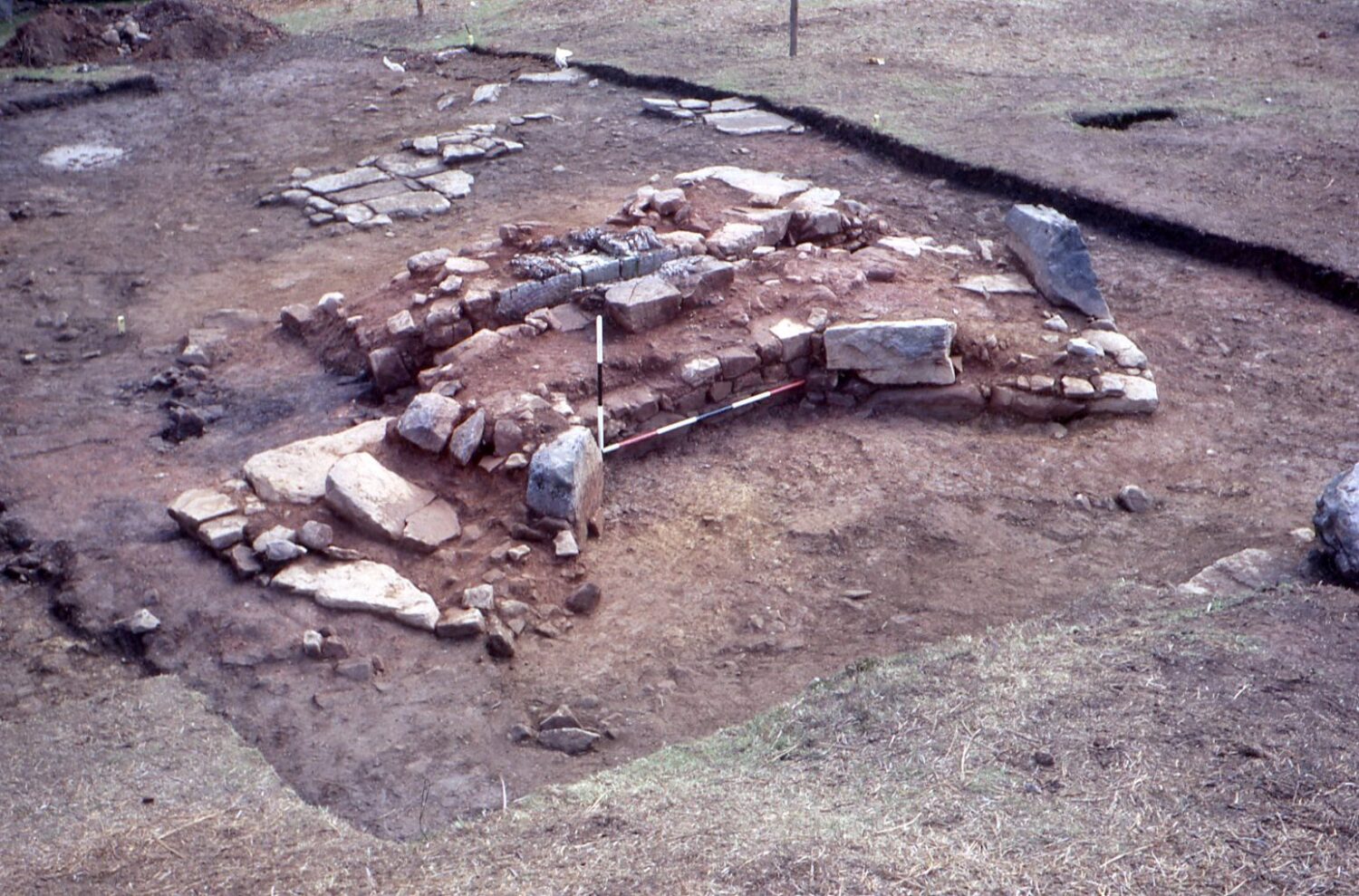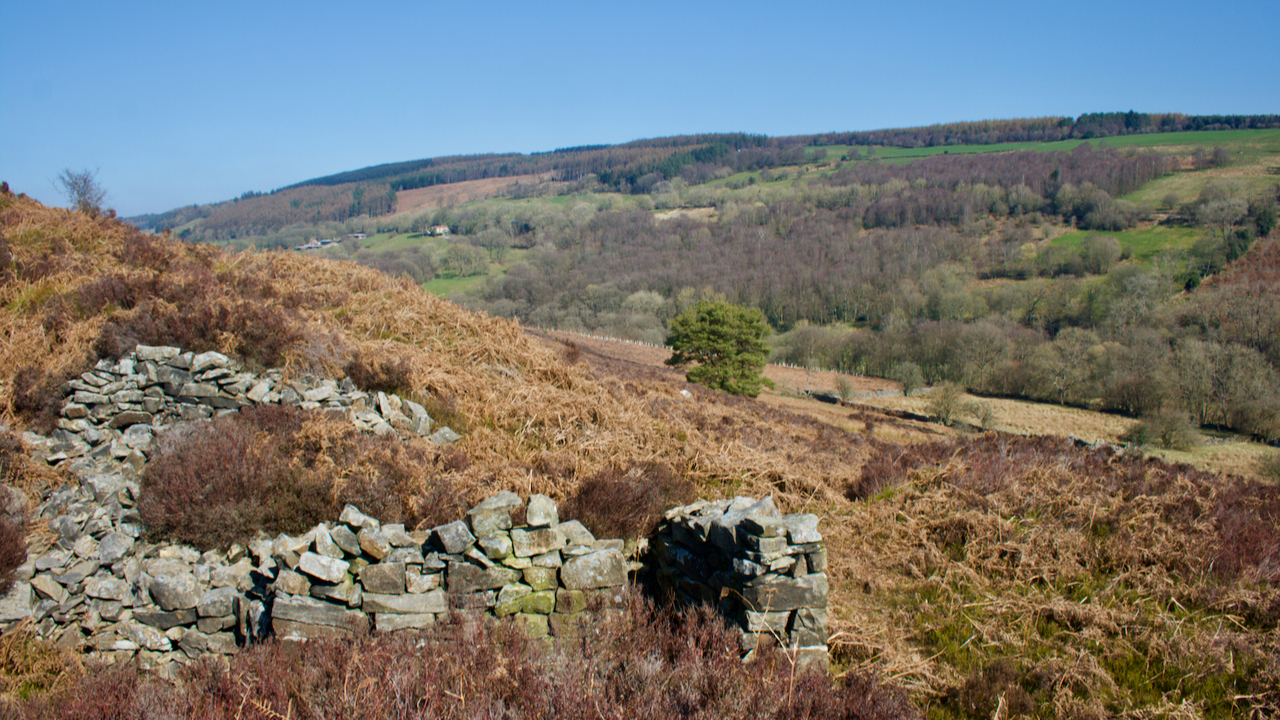I’ve been meaning to explore the lower part of Rosedale for some time. especially the site of an Elizabethan glass works1North York Moors National Park HER Map. GLASS WORKING SITE/GLASS FURNACE/ANNEALING FURNACE/FRITTING FURNACE/OVEN. HER No: 4387 [online] Available at: https://www.northyorkmoors.org.uk/discover/archaeology/her-map [Accessed 26 Mar. 2022]..
A lovely Spring day with blue skies but the site of the works were a little underwhelming. The ruins of a building associated with a 19th-century sandstone quarry was much more interesting2North York Moors National Park HER Map. RUINED BUILDING and QUARRY. HER Nos: 1261/7833 [online] Available at: https://www.northyorkmoors.org.uk/discover/archaeology/her-map [Accessed 26 Mar. 2022]..
On the featured image, if you cast your eyes along the gulley right of centre down the hillside, they should fall on a patch of darkish vegetation. Before the wall. That is about the site of the three furnaces excavated by Raymond Hayes in the late 1960s.

The furnace was believed to have been worked by French Huguenots, fleeing religious persecution back in France in the 16th-century.
They were master glass makers but in Elizabethan England, a special licence was required to produce glass and the monopoly for making drinking vessels was held by London based Italian Jacopo Verzelini3Jacopo Verzelini | Italian craftsman | Britannica. (2022). In: Encyclopædia Britannica. [online] Available at: https://www.britannica.com/biography/Jacopo-Verzelini [Accessed 26 Mar. 2022]..
So the French Huguenots had to operate illicitly in order to survive. Under the radar so to speak. And where better than a remote corner of North East Yorkshire. Rosedale had the ingredients: sand, lime, and wood for fuel, and surprisingly bracken which, when burned, yields sodium oxide enabling sand to melt4Ryedale Folk Museum. (2021). Raymond Hayes and the Rosedale Glassmakers – Ryedale Folk Museum. [online] Available at: https://www.ryedalefolkmuseum.co.uk/raymond-hayes-and-the-rosedale-glassmakers/ [Accessed 26 Mar. 2022]..
Remarkably, it is believed the names of three of the glass workers survive in the parish records of Lastingham: Johannes Coutle, Georgius Rathrome, and Rogerus Romfrey5Ryedale Folk Museum. (2021). Raymond Hayes and the Rosedale Glassmakers – Ryedale Folk Museum. [online] Available at: https://www.ryedalefolkmuseum.co.uk/raymond-hayes-and-the-rosedale-glassmakers/ [Accessed 26 Mar. 2022]..
The glass produced, bottles, vases and so on, had a greenish tinge due to the iron-rich soil of Rosedale. There are believed to have been similar sites in Hutton-le-Hole and Farndale.
In 1592, the licence to make glass was granted to Sir Jerome Bowes6Wikipedia Contributors (2021). Jerome Bowes. [online] Wikipedia. Available at: https://en.wikipedia.org/wiki/Jerome_Bowes#Later_years [Accessed 26 Mar. 2022].. He was more, shall we say, more protective of his monopoly than Verzelini. The French names no longer appear in the records from 1593, and, in 1598, the French Civil War effectively ended with the Edict of Nantes, giving Huguenots religious freedom.
Perhaps finally the French glassmakers felt safe in returning to their home country.
This is a remarkable story of foreign speaking refugees being accepted by a local community.
- 1North York Moors National Park HER Map. GLASS WORKING SITE/GLASS FURNACE/ANNEALING FURNACE/FRITTING FURNACE/OVEN. HER No: 4387 [online] Available at: https://www.northyorkmoors.org.uk/discover/archaeology/her-map [Accessed 26 Mar. 2022].
- 2North York Moors National Park HER Map. RUINED BUILDING and QUARRY. HER Nos: 1261/7833 [online] Available at: https://www.northyorkmoors.org.uk/discover/archaeology/her-map [Accessed 26 Mar. 2022].
- 3Jacopo Verzelini | Italian craftsman | Britannica. (2022). In: Encyclopædia Britannica. [online] Available at: https://www.britannica.com/biography/Jacopo-Verzelini [Accessed 26 Mar. 2022].
- 4Ryedale Folk Museum. (2021). Raymond Hayes and the Rosedale Glassmakers – Ryedale Folk Museum. [online] Available at: https://www.ryedalefolkmuseum.co.uk/raymond-hayes-and-the-rosedale-glassmakers/ [Accessed 26 Mar. 2022].
- 5Ryedale Folk Museum. (2021). Raymond Hayes and the Rosedale Glassmakers – Ryedale Folk Museum. [online] Available at: https://www.ryedalefolkmuseum.co.uk/raymond-hayes-and-the-rosedale-glassmakers/ [Accessed 26 Mar. 2022].
- 6Wikipedia Contributors (2021). Jerome Bowes. [online] Wikipedia. Available at: https://en.wikipedia.org/wiki/Jerome_Bowes#Later_years [Accessed 26 Mar. 2022].

Leave a Reply